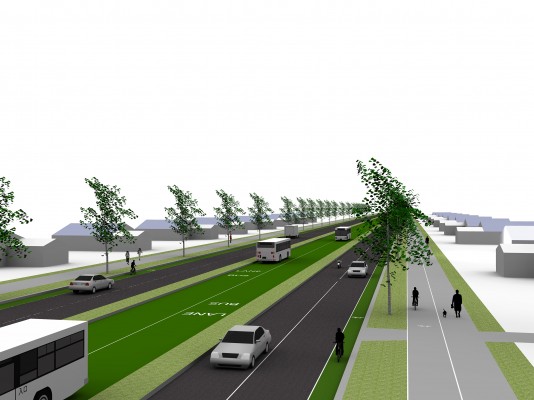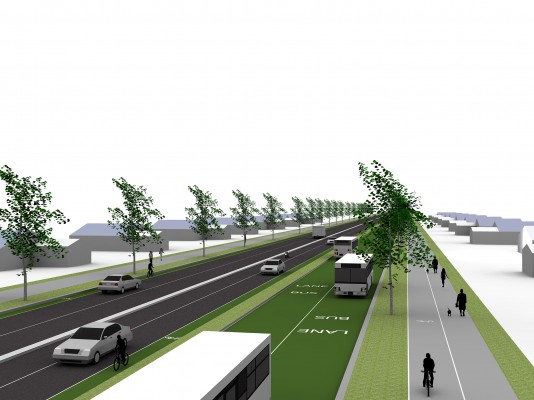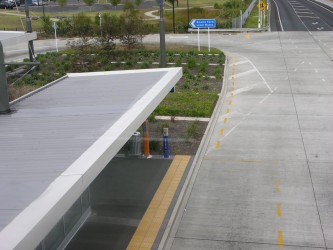Pakuranga Busway Mooted
Auckland Transport will present concepts for a busway to Pakuranga residents this Saturday as part of a project aimed at improving poor public transport in the area.
The dedicated bus lanes along Ti Rakau Drive and a section of Pakuranga Road will be part of a busway that will eventually run from Botany to Panmure train station. It is one of the Eastern Transport Initiative (AMETI) projects which Auckland Transport is now responsible for.
A community open day is being held in Pakuranga to get feedback on two concepts for the busway. Being proposed is a central busway, with lanes in both directions in the centre of the road, and a concept with bus lanes in both directions on one side of the road. Open days were held earlier this year in Panmure to discuss plans for that section of the busway.
The open day will be between 10am and 4pm, with the presentation at 11am at Te Tuhi Arts Centre, 13 Reeves Rd Pakuranga.
Auckland Transport Major Projects Manager Rick Walden says the area has the second lowest public transport use in the region after Whangaparaoa.
“The demand is already there for a rapid transit busway between Panmure and Pakuranga. The problem is that buses are delayed by the same congestion as other vehicles.
“Providing dedicated bus lanes will mean a reliable, high frequency service can be provided. It would allow for up to 60 buses an hour between Pakuranga and Pamure.
“Encouraging more people onto public transport is an important part of dealing with the congestion that is holding back economic growth in the area. It will also mean the planned roading improvements provide better results,” Mr Walden says.
Kerbside bus lanes wouldn’t allow an effective rapid transit as buses would need to slow for turning traffic. There would also be safety issues for residents getting in and out of driveways.
Both the central and one side of the road concepts have all bus stops at signalised intersections so pedestrians would always be able to get to a bus stop safely.
Signalised intersections would provide for right turns into side streets. Access to properties and side streets on one side of the road would continue as it is at present.
For the central busway, u-turns will also be permitted to access properties on the other side of the road. The one side of the road option would mean property access would change to be via signalised intersections and slip roads.
Dedicated cycle facilities would be provided either on-road, off-road or both.
The busway will be developed in stages, based on demand, with the first stages between Panmure and Pakuranga town centre. It will then be created in stages along Ti Rakau Drive towards Botany.
The open day will also provide an update on the overall AMETI project, including other improvements in the Pakuranga area.














16 Comments
Excellent! Busways are the logical solution when heavy rail is not a goer for financial or logistical reasons. But how would the busway get over the Tamaki river? New bridge?
This sounds like a reasonable option to tack on to the massive roadfest that is AMETI. As much as I’d love to see a rail line out that way I can’t see a billion dollars or so forthcoming in a hurry.
Definitely should use central bus lanes, putting a two way busway on one side of the road would cause property access issues, more conflicts with turning traffic and result in the busway catching the red light more often at intersections.
Also probably asking for trouble as motorists aren’t going to expect a buses going the ‘wrong way’ up the side of a main road.
Doloras, a duplicate highway bridge over the Tamaki has been a long standing component of AMETI. Presumably the busway will simply occupy a lane each way on this bridge pair.
The real question is where do all the buses go on the city side side of the river? Will there be a new busway across the ithsmus to the CBD? Will the buses dilute across the various existing bus routes like Remuera Rd or Great South Rd, or will they plan to transfer everybody at Penrose?
I’m glad that they are thinking of central bus lanes rather what we have done on most roads and just painted them on the side. Along with the benefits mentioned of less disruption to the buses it also gives them more prominence and more people are likely to be attracted to the service.
Nick - I would like to see an eastern rail line as well but luckily this doesn’t prevent it, in fact it would probably compliment it well as by the time the powers that be realise we need it and get round to funding it this would have long paid itself off and would still be an important link in the chain.
Good news, the area needs something to reduce private passenger car use big time!
Just as long as any development is future proofed for rail, I shall be fairly happy
So why are more motorway lanes so important for the area when for about the same development costs a connection to the rail network could be achieved.
The price tag is about $1.8 billion if I remember correctly.
The 1960s road ideas need to be put to pasture. Rail will take huge amounts of cars of the existing roads.
Yeah, I agree with Travis. A future-proofed for rail centre lane rapid-transit buslane is ok. Like the Northern Busway it has the ability to be popular without the huge intial capital required for rail. As long as sometime in the future when it hits capacity, it can be developed into mass-transit rail. If we are going to be spending heaps on rail, it has to be on the CBD tunnel first. Everything else comes later.
One Eye, Simon, I quite like this street-busway concept and to be honest it is about the best we can expect from a massive roading project (it is after all simply a road for buses).
Personally I think the goal should be to build this first and work toward establishing a rail corridor on a different alingment, one that goes further up via HIghland Park or Botany.
There is no reason we cannot have this bus corridor plus a rail corridor out east.
This busway will be all but impossible to future-proof for (heavy) rail. It could probably be future-proofed for light rail pretty easily, but heavy rail? Totally different beast. To start with, all intersections would have to have level crossings or bridges/overpasses (since level crossings are not preferred on new heavy rail lines). Then we’d have the added complications of needing more space for train stations and needing to prevent such a future rail line from cutting in half the suburbs it goes through even more than the streets do - a busway conceivably could still have lots of at-grade pedestrian crossings without too much pedestrians safety issues (though I note the Northwestern Busway has no pedestrian crossing points - but then it travels along a motorway anyway).
In all, this is a great solution for the next 2-3 decades, but I would not worry too much about rail future proofing. Let’s get the East a taste of what good PT can be like, and they may start calling for more down the line.
Pretty good I think. However If I was going to stick Public transport in the centre I’d use modern trams that you have in place Like Amsterdam and Dresden.
The the lane can be grassed (looks so much nicer) and those trams tracks look pretty cheap to build in comparison to a road or train tracks.
Plus, Trams are far nicer to use than buses
Yes definitely nicer than buses tho no one seems to be compalining about the Northern Express. But trams are more expensive to build and don`t give much more capacity right? I think that`s been an argument against them on the Northern Busway that it should stay buses till capacity is hit then changed to heavy rail. Similar capacity at much higher cost doesn`t seem good value for money particularly when that commodity is in short suply for PT projects.
“Doloras, a duplicate highway bridge over the Tamaki has been a long standing component of AMETI. Presumably the busway will simply occupy a lane each way on this bridge pair.”
Talking with the consultants this weekend, they seemed to imply that Panmure Bridge would be a duplication, rather than an integral new bridge. Fair enough in some ways, makes managing the traffic during construction much less of a nightmare.
“But trams are more expensive to build and don`t give much more capacity right?”
Actually, they do. A normal bus can basically not cater for more than 80-120 passengers, whereas larger trams can carry up to 500 (and we aren’t talking Japanese subway crush levels, just normal peak loads). They also offer higher ride comfort, and are much more attractive to punters. They run off electricity, which means when fossil fuel spikes, your PT authority doesn’t have to shout for more money to cover their operating costs. So there’s certainly lots of advantages.
In this case however, it would mean creating a whole new system for Auckland (no trams left at the moment) so future-proofing alone is okay.
Max, a bus carrying 80-120 would have to be very long and articulated. About 50 people would be the capacity of a ‘normal’ bus in Auckland.
Likewise the 500 capacity trams would probably be out of the question in Auckland as they would be so long they’d block intersections etc.
Something like the Melbourne C2 and D2 class trams that support 200 people each would be more appropriate.
Probably they greatest benefit of trams is this fact that they carry four or so times as many people per vehicle. This cuts labour costs down to one quarter that of buses and relieves street routes that are heavily congested with buses, however this would only be suitable on the busiest routes that follow a single corridor.
Nick R - bendy buses can carry up to 200 people, so doesn’t seem to really match (maybe we are disagreeing on max load and seated load?) .
Also, the longest trams (from where the 512 passengers NON-crush load figure is from) are 72 meters. Our intersections are further apart than that, especially on a corridor that has signalised crossings over the tramway only.
http://transportation.siemens.com/en/data/pdf/ts_internet/ts_tr/avenio_a19100-v520-b452-x-7600.pdf
I am not saying this should be what we should do in Botany - but trams do indeed have this level of capacity.
Bendies in Auckland carry about 80 people. Yes there are longer options overseas but they would not be legal to run on New Zealand streets under the current rules, and furthermore they would probably require full busway routes (like in Curitiba or Bogota) rather than the local practice of running on street in the city and town centres.
I’m not denying there are trams that are very long with large capacities overseas, just saying they would be impractical in Auckland. If they were run solely on the new busway alignment then maybe, as this is a long straight route with a wide road width. However I doubt it would be practical to have 72m long tram stops in Newmarket or the CBD for example. Finding anywhere flat and straight enough for that would be a major issue.